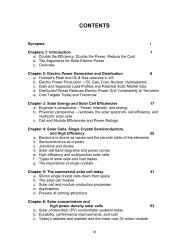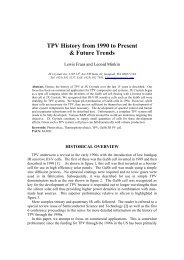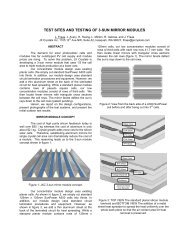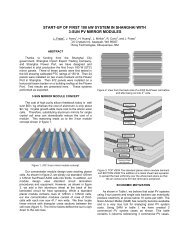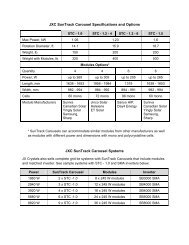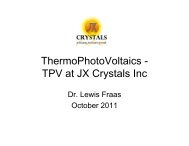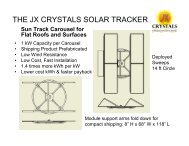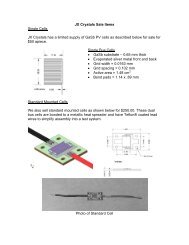TPV GENERATORS USING THE RADIANT TUBE ... - JX Crystals
TPV GENERATORS USING THE RADIANT TUBE ... - JX Crystals
TPV GENERATORS USING THE RADIANT TUBE ... - JX Crystals
You also want an ePaper? Increase the reach of your titles
YUMPU automatically turns print PDFs into web optimized ePapers that Google loves.
The process used to fabricate this cell replicates siliconsolar cell processing, using inexpensive diffusion stepswith no toxic gases, in contrast with epitaxy. <strong>JX</strong> <strong>Crystals</strong>has patents and licenses on GaSb cells and circuits [2].The second key component in our <strong>TPV</strong> system is anantireflection (AR) coated refractory metal emitter. Theconcept resembles the incandescent light bulb. Metals liketungsten (W) have low emittance at long wavelengths andhigher emittance at shorter wavelengths. In our IR emitter,the AR coating amplifies the material emittance in the cellconvertible band for wavelengths less than 1.7 microns [3],as detailed in <strong>JX</strong> <strong>Crystals</strong>’ issued patent [4].Referring to the measured emittance curve in figure 3,our IR emitter has an emittance over 0.7 in the cellconvertible band and a low emittance below 0.2 beyond 3.5microns. However, it is necessary to recycle the energyemitted in the 1.7 to 3.5 micron mid-wavelength band. Thiscan be done with a simple nine layer dielectric filter asshown in figure 4. This filter is fabricated with alternatinglayers of silicon and silicon dioxide.1.00.80.60.40.201 2 3 4 5micronsFigure 3: Measured emittance for AR coated tungsten.1.00.80.60.40.201 2 3 4 5micronsFigure 4: Reflectance for nine layer dielectric filter.3. BASIC <strong>THE</strong>ORY OF SPECTRAL CONTROLThe power spectrum passing through our filter from ourAR/W emitter can be calculated in two ways. The easierway is to assume normal incidence and perform an infinitesum for each wavelength. The second method uses aMonte Carlo program called TracePro, allows us to accountfor rays emitted at all angles given a 3D geometry. Infigure 5, the power spectra are displayed for both methodsassuming a 1300 C emitter. The geometry assumed for the3D case is a 3.3” φ cylindrical emitter with a 5” φphotovoltaic array and perfect end mirrors (an idealizedrepresentation). The filter suppresses the absorbed powerin the mid-wavelength band and the emitted power at longwavelengths is low. This means that there is good spectralcontrol; most of the power arriving at the cell array is in thecell response band. Also, note that the effect of rays withvarying angles (3D) is to broaden the power spectra peakrelative to the normal incidence (1D) case.Table I shows the predicted results using <strong>JX</strong> <strong>Crystals</strong>’three key components. Spectral efficiency is 75% and a<strong>TPV</strong> conversion efficiency of approximately 23% shouldbe possible. Note that the 3D case actually has slightlyhigher efficiency and power densities than the 1D case, apleasant surprise. These calculations are theoretical, usingreal component measured data. In the following sections,we describe a real and more complete <strong>TPV</strong> system.7654321Monte Carlo Model1D model01 2 3 4 5microns micronsFigure 5: Absorbed power spectra for 1D and 3D models.Table I: Model results for Temitter=1300° C, Tcell=50° C,3.3” φ emitter, 5” φ cell array (view factor=0.66),and perfect end mirrors.1D 3DIsc (A/cm 2 ) 3.52 3.98Voc 0.444 0.447Fill factor 0.728 0.725Pmax (W/cm 2 ) 1.15 1.30Pin(total) (W/cm 2 ) 5.16 5.53Pin(inband) (W/cm 2 ) 3.80 4.17Spectral efficiency 73.6% 75.4%Pmax / Pin(total) 22.3% 23.4%Pmax / Pin(inband) 30.3% 31.1%4. GENERATOR DESIGN AND FABRICATIONA tungsten emitter can not be operated in air. Thisintroduces a requirement for operation in an inert gas andconsequently a need for a tightly sealed enclosure. Whilethis requirement may appear daunting, it is encouragingthat common light bulbs are sealed and operate with thetungsten filament at 2800 C. Furthermore, conduction andconvection losses from the emitter to the PCA aresignificant in air and can be reduced by a factor of threewith Krypton backfill.The vertical cross section depicted in Figure 6 showsmore detail for our <strong>TPV</strong> generator design. Note that inorder to keep the hermetic seal between the PCA and theemitter support tube from overheating and to avoid heatlosses at this seal, there is a fold back section in the emittersupport tube. Besides reducing heat losses at the seal, thisfold back section also leads to a more efficient and compactdual-disc recuperator design.Figure 7 shows the inner disc stack that is used in ourrecuperator. In this inner stack, hot exhaust gases flowdown in contact with the outer fins which capture heat andtransfer it to the combustion air flowing upward inside incontact with the inner fins. Referring to figure 6, there is asecond larger diameter finned disc stack concentric withthis inner finned stack.



